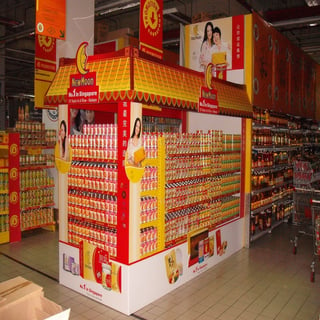 When you walk into the grocery store, typically you know what you are looking for. You may have a list typed out on the notepad of your smartphone, go for the old school paper list, or you just generally know what products you buy each week. Heading to the first item on your list, you see a stand up display advertising a special deal for the product it contains. It may include audio, lights, or even moving parts. You think, do those actually work? Could it pull me away from heading for the items I know I’m looking for? The answer is yes.
When you walk into the grocery store, typically you know what you are looking for. You may have a list typed out on the notepad of your smartphone, go for the old school paper list, or you just generally know what products you buy each week. Heading to the first item on your list, you see a stand up display advertising a special deal for the product it contains. It may include audio, lights, or even moving parts. You think, do those actually work? Could it pull me away from heading for the items I know I’m looking for? The answer is yes.
Studies have shown that shoppers are largely impulsive, and that end cap displays and point of purchase, or POP, ads really do boost sales. POPAI, Point of Purchase Advertising International, found that 70% of US shoppers make purchase decisions in store. An effective, catchy display could be the difference in gaining a new loyal user of your product.
In their book Advertising Promotion and Other Aspects of Integrated Marketing, Terrence A. Shimp and J. Craig Andrews outline four main reasons why end cap displays and point of purchase promotions are successful: informing, reminding, encouraging, and merchandising. Informing simply points out new information to the shopper, bringing the product to their attention.
Reminding causes the shopper to recollect prior knowledge or experience they have with that brand. Seeing the ad in the store reminds them of ads they saw in magazines, heard on the radio, or watched on TV, and gives them some context for the display ad they are seeing in store. Encouraging is the act of motivating the consumer to purchase the product. As noted above, 70% of US shoppers make impulse buy decisions. The goal of the point of purchase ad is to get someone to act impulsively to the benefit of your product. Finally, merchandising, allows for creative and efficient use of retail space. Harnessing these four tactics, end cap displays, and point of purchase ads can be highly effective.
Knowing how beneficial these types of ads can be, you want to make sure your reps and brand are leveraging them to their full potential. Shimp and Andrews note a study conducted by Procter and Gamble after the advent of RFID chips. The chips enabled them to track where in the store their display was placed, as well as exactly when it was put up and taken down. Procter and Gamble discovered that one third of their retailers did not follow through on their agreement to set up their displays. Furthermore, they discovered that retailers only set up their displays correctly 45% of the time.
Given this insight, finding a tool that makes it easier to keep track of displays can be invaluable. Have field reps who are invested in the product set up the display and send a photograph to their field manager demonstrating that it was properly constructed and placed in the proper location in the store. Exchanges of real-time photos of displays will motivate those in charge of its upkeep to follow through. This will assist reps in assuring compliance with the retailer contracts, and work as incentive for the end cap, pop ad, or display to be properly maintained to preserve a positive relationship between the retailer and brand.
Point of Purchase advertising has proven to be quite successful at grabbing consumers attention, getting them to try a product they may not have otherwise, and potentially create a new loyal customer from an impulse buy. If you are planning on leveraging the benefits of point of purchase ads, be sure to have tools in place that allow you to keep track of your displays like Field Activity Management software. Harnessing the photo feature of Field Activity Management software not only ensures that your product has the greatest chance of being sold, it also holds field reps and retailers accountable to following through on agreements, resulting in maximum ROI for your brand.


 When you walk into the grocery store, typically you know what you are looking for. You may have a list typed out on the notepad of your smartphone, go for the old school paper list, or you just generally know what products you buy each week. Heading to the first item on your list, you see a stand up display advertising a special deal for the product it contains. It may include audio, lights, or even moving parts. You think, do those actually work? Could it pull me away from heading for the items I know I’m looking for? The answer is yes.
When you walk into the grocery store, typically you know what you are looking for. You may have a list typed out on the notepad of your smartphone, go for the old school paper list, or you just generally know what products you buy each week. Heading to the first item on your list, you see a stand up display advertising a special deal for the product it contains. It may include audio, lights, or even moving parts. You think, do those actually work? Could it pull me away from heading for the items I know I’m looking for? The answer is yes..png?width=480&height=252&name=PRESS%20RELEASE-2%20(4).png)

